The following group of films include five that form a "series" of sorts despite change of stars & poor continuity from film to film. The first one regards the mummy Imhotep motivated, however horrifically, by love that spans millenia. Four of the five feature the mummy Kharis who is similarly associated with a forbidden love of the ancient world, who is brought to life by tana leaves, which can also be used to control him. Also considered in this group are three contemporary parodies that played off the popularity of the Universal's mummy.
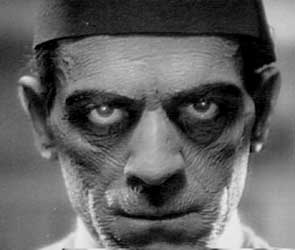 Although I've re-watched all the Universal films as an adult, the strongest impressions will always be those which imbedded themselves in my mind as a kid staying up late on Friday nights to see the old Universal classics. I will never be able to watch them without nostalgia, & I wonder if today's typical horror fan would get as much out of them as I do, having not been exposed to them from childhood on. Although I've re-watched all the Universal films as an adult, the strongest impressions will always be those which imbedded themselves in my mind as a kid staying up late on Friday nights to see the old Universal classics. I will never be able to watch them without nostalgia, & I wonder if today's typical horror fan would get as much out of them as I do, having not been exposed to them from childhood on.
In most cities these used to play on late-night tv, in days when not everything had to be in color to make it onto television. So they were as familiar to young horror fans of the 1960s & 1970s just as they'd been with the generation of the 1930s through 1950s who saw them at Saturday matinees. Nowadays viewers have to think about classic horror films & make the effort to track them down to purchase or rent, & I'm sorry whenever I see junkier modern product (such as from Troma) getting so much fan coverage, while classics are neglected.
The Mummy (1932) featured Boris Karloff in the titular role. It's deservedly regarded a classic, an A picture with gorgeous cinematraphy & convincing performances. The tomb sequence when the mummy is awakened is just tremendous.
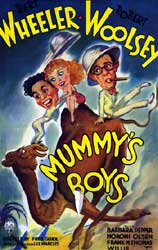 After he is "restored" to a fez-wearing craggy dude with an ancient agenda, he's still fun to look at because heck it's Boris, even though the rest of the story doesn't feature a wrapped up mummy. After he is "restored" to a fez-wearing craggy dude with an ancient agenda, he's still fun to look at because heck it's Boris, even though the rest of the story doesn't feature a wrapped up mummy.
The Mummy was parodied in the Wheeler & Woolsey comedy vehicle Mummy's Boys (1936) but that one's too stupid for words & the mummy of King Pharatime turns out to be a hoax. Wheeler & Woolsey were an inferior version of Laurel & Hardy or Abbott & Costello, justifiably all but forgotten. See comments on their career in the review of Dixiana (1930).
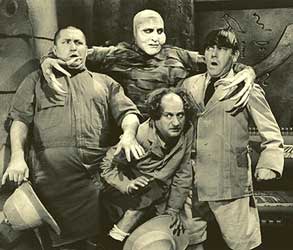 It's interesting that after only one mummy film from Universal, already the theme is being thought of as suitable for laughter. It's interesting that after only one mummy film from Universal, already the theme is being thought of as suitable for laughter.
Before the Universal franchise was revitalized in 1940, it would again be parodied by the Three Stooges in the short subject We Want Our Mummy (1939).
Moe, Larry & Curly catch a taxi from the Bronx to Egypt where they become involved in pratfalls involving two mummies, King Rootintootin & Queen Hotsytotsy.
In the second otherwise serious mummy film, The Mummy's Hand (1940), there was also a lot of comedy relief, courtesy of Wallace Ford as overt comic sidekick, but also by the more subdued humor of Cecil Kellaway as a dithering magician who funds the archeological expedition.
It begins with some footage from the 1932 film to imply a sequel, but content-wise it is the first of what would be a distinct series, touchstones with the Karloff film being few to none. This is not a problem, because it permits the original mummy film to stand alone as an unrivaled masterpiece undiluted by bringing him back to life for cheaper & cheaper sequels.
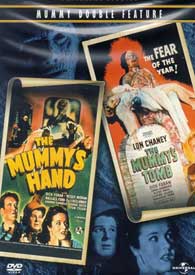 The Mummy's Hand did not have Karloff or Chaney under the wraps, but Tom Tyler as the mummy Kharis, whose better at it than would be Lon Chaney Jr., creating the classic shambling gimpy gait that most children would be imitating for the next thirty years, & having a blind gaze as disturbing as any gaze cinema has ever offered. The Mummy's Hand did not have Karloff or Chaney under the wraps, but Tom Tyler as the mummy Kharis, whose better at it than would be Lon Chaney Jr., creating the classic shambling gimpy gait that most children would be imitating for the next thirty years, & having a blind gaze as disturbing as any gaze cinema has ever offered.
This was a cool film with marvelous set designs. It happily scared the bejabbers out of me when I was a pre-teen watching it late Friday night on TV, maybe even introduced by early vampire host Zacherley, or an imitator of Zacherly.
The mummy is pure mute evil & less complex than in the original, though there's an element of pathos regarding his need for tana leaves to retain his semblance of life. Since the Mummy is somewhat animalistic this time, the intellect behind the evil is the high priest played marvelously by George Zucco.
The Mummy's Hand set a tone for further episodes & to whatever degree the rest of the series succeeds, it only does so in imitation of this.
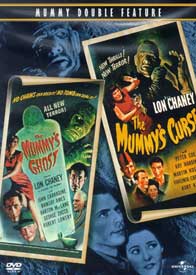 The Mummy's Tomb (1942) is not half so good, but is blessedly short so over with in a hurry. Presumedly a sequel to Hand it comes off as merely recycled bits from Hand. This time Lon Chaney is under the wraps except in some recycled footage, & he was too chunky to do it well. The Mummy's Tomb (1942) is not half so good, but is blessedly short so over with in a hurry. Presumedly a sequel to Hand it comes off as merely recycled bits from Hand. This time Lon Chaney is under the wraps except in some recycled footage, & he was too chunky to do it well.
The Mummy looks best tall & lanky like Christopher Lee, or Boris, or even Tom Tyler, but one does get used to Chaney after a while. It is the weakest film of the set, but the franchise happily bounces back with:
The Mummy's Ghost (1944) has Chaney again, & George Zucco reprises his high priest role a third time (despite that he was definitively killed in The Mummy's
Tomb). Plus there's John Carradine who'd also like to regain possession of Kharis the dead-alive mummy carted off to an American museum. A plethora of character actors can make even a cheap film like this exciting.
In this episode the Mummy has a Romanticist presence. There is a creepy-tragic ending wherein the maiden dies in a swamp along with the mummy & she's a mummy too -- kind of surreal, & very unexpected of monster films of the time which always saved the heroine. I didn't understand it at all when I was a kid but it made me think real hard.
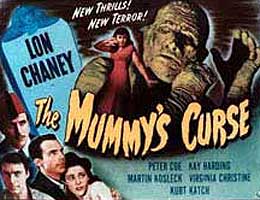 The series officially ended with the fifth film, the fourth about Kharis, The Mummy's Curse (1944). This one has Chaney for the third & last time. The series officially ended with the fifth film, the fourth about Kharis, The Mummy's Curse (1944). This one has Chaney for the third & last time.
The heroine who died sinking in the swamp at the end of Ghost rises out of the swamp at the beginning of this one.
It's a very eerie opening scene, picking up exactly where it ended in the previous episode (& never mind that the swamp they sank into was in Massachusetts, but the swamp they come out of is the Louisiana boyou, we'll just assume all swamps are connected by murky muddy tunnels that connect even to England for when Hammer Films takes up the torch).
When the swamp is drained, the mummy of Kharis is uncovered, & his love-quest to be reuinited with the princess of ancient Egypt is once again in full sway.
This extremely short film delivers some good B-horror stuff as it progresses, though it recycles scenes from earlier films (even a moment of the Karloff original gets inserted), rendering its mere 59 minutes even less for new material. The length seems a cheat, but it was made for days when for a dime you could see two films, a serial episode, newsreels, & cartoons.
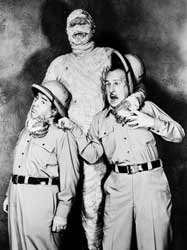 The Mummy's Curse never offers a second scene as stunning as Princess Ananka rising from the swamp, & the great chraracter actors who populated the earlier episodes of the Kharis cycle are curiously missing from this final outing. The Mummy's Curse never offers a second scene as stunning as Princess Ananka rising from the swamp, & the great chraracter actors who populated the earlier episodes of the Kharis cycle are curiously missing from this final outing.
Kharis brings down ruins upon himself in the climax, & certainly could've had the rubble lifted off of him for another rehash, but Universal Studios was not to take it further.
With Abbott & Costello Meet the Mummy (1955) it has been widely asserted that the death-knell was wrung for Universal's mummy, which was forever after only good for jest. However, since the theme was being parodied even in the 1930s, & the 1940 sequel was itself riddled with comedy, it can't be argued that parody put an end to Kharis's immortality.
In fact mummies had been providing excuses for filmic comedy since the silent era, as in the short The Mummy (1911) which has an Egyptologist harrassed by the desirous advances of a female mummy, & several similar short mummy comedies from the 'teens which are either lost or not in circulation. Much more demeaning to the original than Abbot & Costello's enjoyable film (which i think really does deserve to be regarded as the sixth in the series) would be the agregiously bad Aztec mummy series from Mexico which began in 1957.
Hammer Studio inherited the mantle of the series, extending the Kharis mythology by official agreement with Universal Studios. The first in the new series was Terance Fisher's The Mummy (1959) which can easily be regarded a continuation of the old black & white franchise, Kharis's further adventures rather than only a remake. But a discussion of the Hammer set will have to await another day.
copyright © by Paghat the Ratgirl
|
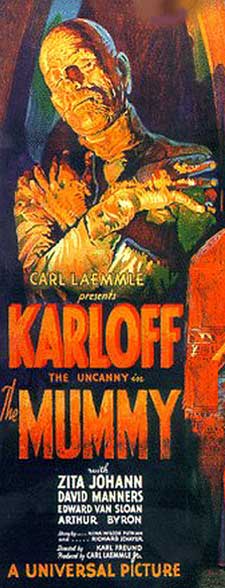
 Although I've re-watched all the Universal films as an adult, the strongest impressions will always be those which imbedded themselves in my mind as a kid staying up late on Friday nights to see the old Universal classics. I will never be able to watch them without nostalgia, & I wonder if today's typical horror fan would get as much out of them as I do, having not been exposed to them from childhood on.
Although I've re-watched all the Universal films as an adult, the strongest impressions will always be those which imbedded themselves in my mind as a kid staying up late on Friday nights to see the old Universal classics. I will never be able to watch them without nostalgia, & I wonder if today's typical horror fan would get as much out of them as I do, having not been exposed to them from childhood on. After he is "restored" to a fez-wearing craggy dude with an ancient agenda, he's still fun to look at because heck it's Boris, even though the rest of the story doesn't feature a wrapped up mummy.
After he is "restored" to a fez-wearing craggy dude with an ancient agenda, he's still fun to look at because heck it's Boris, even though the rest of the story doesn't feature a wrapped up mummy. It's interesting that after only one mummy film from Universal, already the theme is being thought of as suitable for laughter.
It's interesting that after only one mummy film from Universal, already the theme is being thought of as suitable for laughter. The Mummy's Hand did not have Karloff or Chaney under the wraps, but Tom Tyler as the mummy Kharis, whose better at it than would be Lon Chaney Jr., creating the classic shambling gimpy gait that most children would be imitating for the next thirty years, & having a blind gaze as disturbing as any gaze cinema has ever offered.
The Mummy's Hand did not have Karloff or Chaney under the wraps, but Tom Tyler as the mummy Kharis, whose better at it than would be Lon Chaney Jr., creating the classic shambling gimpy gait that most children would be imitating for the next thirty years, & having a blind gaze as disturbing as any gaze cinema has ever offered.

 The Mummy's Curse never offers a second scene as stunning as Princess Ananka rising from the swamp, & the great chraracter actors who populated the earlier episodes of the Kharis cycle are curiously missing from this final outing.
The Mummy's Curse never offers a second scene as stunning as Princess Ananka rising from the swamp, & the great chraracter actors who populated the earlier episodes of the Kharis cycle are curiously missing from this final outing.